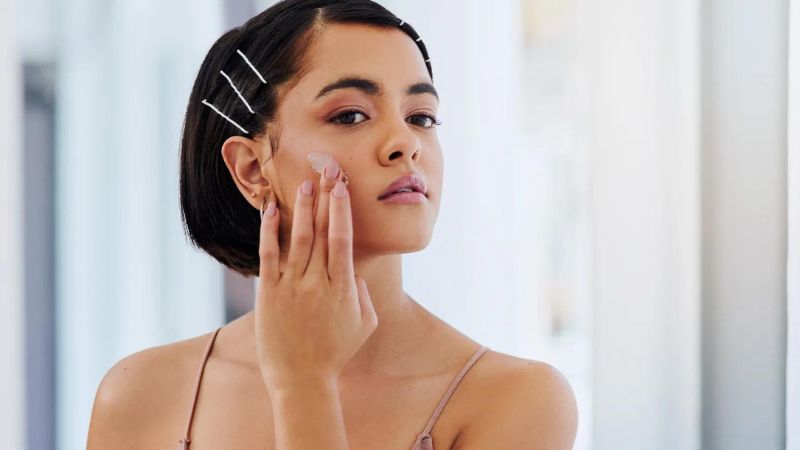Understanding how to layer your skincare products correctly is essential for achieving healthy, radiant skin. With countless products available, knowing the right order can make all the difference in their effectiveness. Applying products from the thinnest to the thickest consistency is the basic rule of thumb.
By doing this, you can be sure that every product fully penetrates your skin and gives you the maximum benefits of your skincare regimen. Whether you’re using serums, moisturizers, or treatments, mastering the art of layering will help you maximize hydration, target specific skin concerns, and create a luminous complexion. In this guide, we’ll explore the ideal order for applying your favorite products and tips to personalize your routine for optimal results.
How To Layer Your Skincare Products In The Right Order
1: Cleanser
The first step in your skincare routine should always be cleansing. Cleansing removes dirt, oil, and impurities from the skin’s surface, preparing it for the subsequent products. Choose a cleanser suitable for your skin type—whether gel, cream, or oil-based. For example, those with oily skin may benefit from a foaming or gel cleanser that deeply cleanses and controls excess oil. In contrast, individuals with dry skin should opt for a creamy or oil-based cleanser that hydrates while cleansing.
To cleanse effectively, apply the product to damp skin and gently massage it in circular motions for about 30 seconds. After giving your skin a thorough rinse with lukewarm water, blot it dry with a fresh towel. This step is crucial, as it sets the stage for the rest of your routine, allowing serums and treatments to penetrate more deeply and effectively.
Also Read:- Skincare Routine For Acne Prone Skin
2: Toner
After cleansing, the next step is applying toner. Toners help balance your skin’s pH levels and prepare it for better absorption of the following products. They can also provide additional hydration and remove any leftover impurities. Toners come in various forms, including liquid, mist, and gel, and may contain ingredients tailored to specific skin concerns—such as exfoliating acids for oily skin or hydrating agents for dry skin.
To apply toner, use a cotton pad or your hands to distribute it evenly across your face and neck. Before proceeding to the following step, give it time to fully absorb. Regular use of toner can enhance your overall skincare routine, providing a refreshing boost while ensuring your skin remains hydrated and ready for serums and moisturizers.
3: Serums and Treatments
The third step in your skincare routine involves applying serums and targeted treatments. Serums are lightweight formulations packed with concentrated active ingredients designed to address specific skin issues, such as wrinkles, dark spots, or hydration. Since serums have smaller molecules, they can penetrate deeper into the skin compared to heavier creams. This is why applying them after toner is critical.
When selecting a serum, consider your skin concerns. For instance, vitamin C serums are excellent for brightening the skin and providing antioxidant protection, while hyaluronic acid serums are great for deep hydration. A few drops should be applied to your fingertips, then gently pressed into your skin, paying particular attention to areas that require more care. Allow the serum to absorb fully before proceeding to the next step to ensure maximum effectiveness.
4: Moisturizer
Following serums, it’s time to apply moisturizer. Moisturizers are crucial for locking in hydration and providing a barrier against environmental aggressors. They come in various formulations, including creams, lotions, and gels, allowing you to choose one that suits your skin type. For oily skin, lightweight, oil-free moisturizers are ideal, while those with dry skin may benefit from richer creams that provide intense hydration.
To apply moisturizer, take a small amount and gently massage it into your face and neck using upward strokes. This not only hydrates your skin but also promotes circulation and can enhance your skin’s overall texture. Applying moisturizer after serums helps seal in the beneficial ingredients, ensuring that your skin remains hydrated and protected throughout the day or night.
Also Read:- Best Skincare Routine For Sensitive Skin
5: Sunscreen (Day Routine)
If you’re following your skincare routine in the morning, the final step should always be sunscreen. Sunscreen is necessary to shield your skin from UV radiation, which can cause dark spots, premature aging, and even skin cancer. To guarantee sufficient protection, choose a broad-spectrum sunscreen with at least SPF 30.
To apply, use a generous amount and distribute it evenly across your face and neck. Take care to apply it even on cloudy days because UV radiation can penetrate clouds. Additionally, reapply every two hours, especially if you are outdoors or sweating. Including sunscreen in your daily routine is a vital step in maintaining healthy skin and preventing damage caused by sun exposure.
Conclusion
By layering your skincare products in the correct order, you can enhance their effectiveness and improve your skin’s overall health. Remember to start with lightweight formulations and finish with thicker creams to lock in moisture. Everyone’s skin is unique, so don’t hesitate to adjust your routine based on your specific needs. With a little experimentation, you’ll discover the perfect layering technique that works for you.
FAQs
Which skincare product application sequence works best?
The best order is typically: cleanse, tone, treat (serums), moisturize, and finally, apply sunscreen in the morning.
Can I mix different skincare products?
Yes, but be cautious. Some ingredients may not work well together; for instance, avoid mixing retinol with vitamin C at the same time to prevent irritation.



